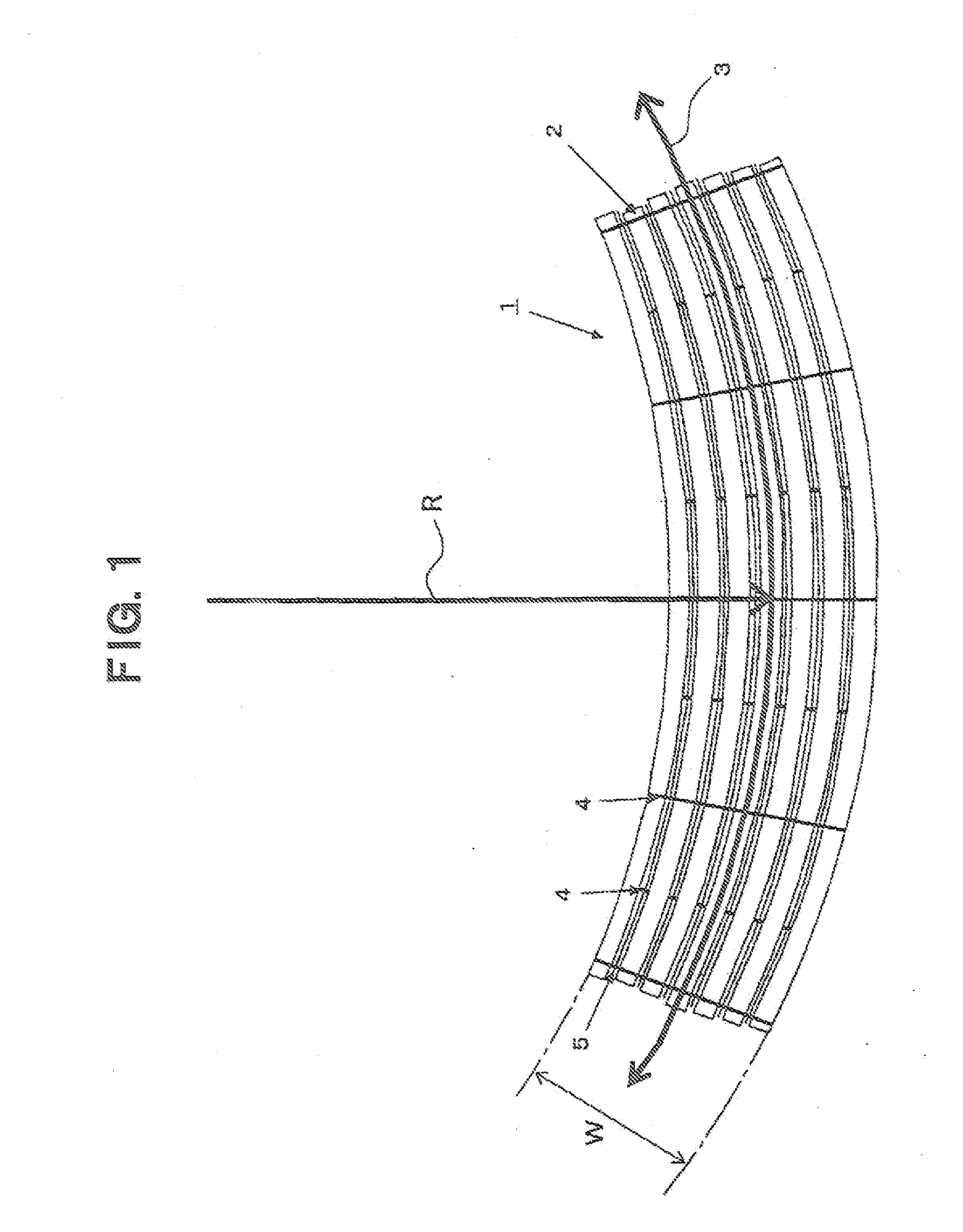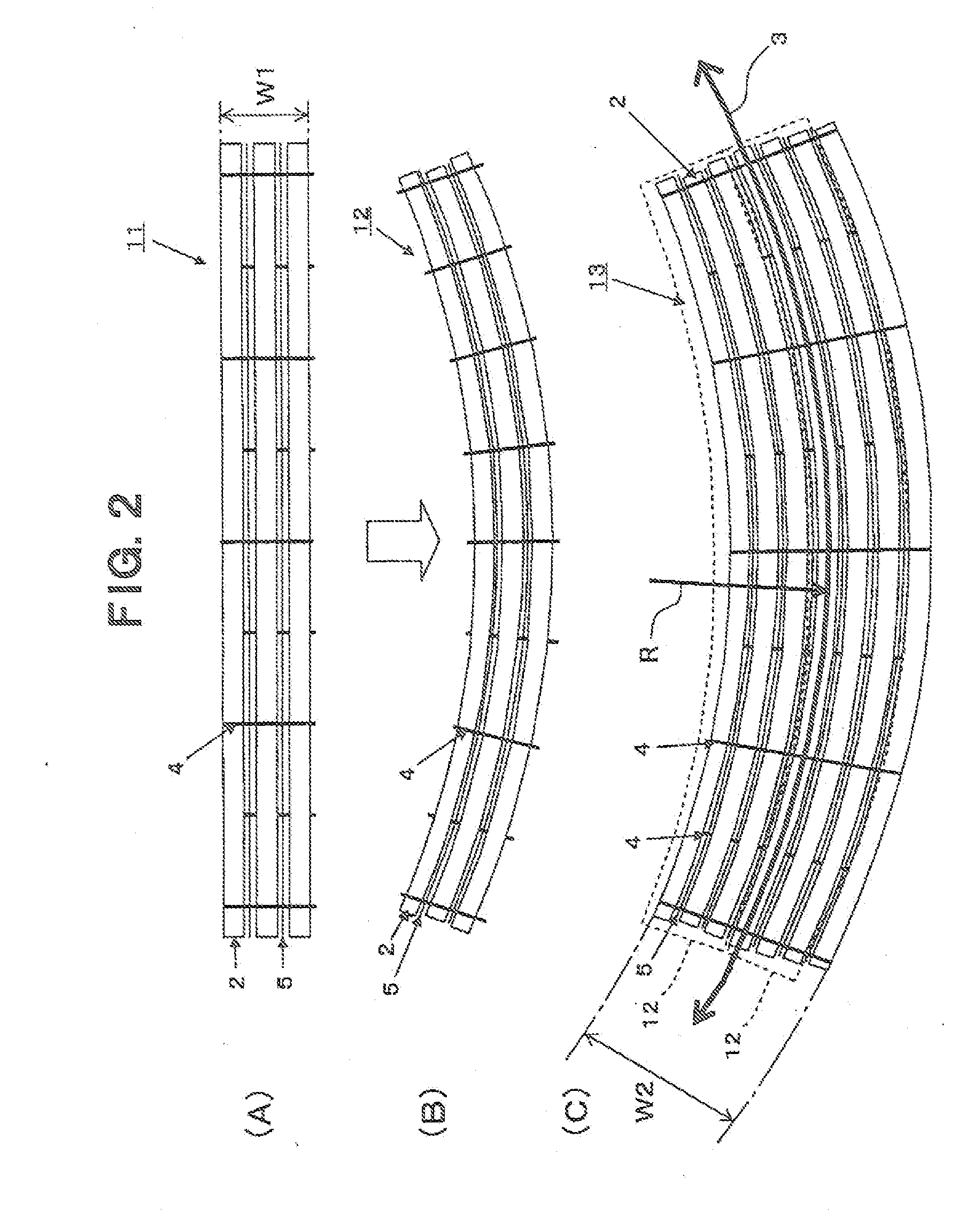Reinforcing fiber substrate of curved shape, layered product using the same, preform, fiber-reinforced resin composite material, and processes for producing those
a technology of reinforced fiber and curved shape, which is applied in the direction of weaving, other domestic articles, synthetic resin layered products, etc., can solve the problems of poor productivity, inability to correct layered products, poor productivity, etc., and achieves the improvement of circumferential properties, simple structure, and low cost.
- Summary
- Abstract
- Description
- Claims
- Application Information
AI Technical Summary
Benefits of technology
Problems solved by technology
Method used
Image
Examples
example 1
[0237]Using a weaving machine for curved reinforcing fiber substrate 161 shown in FIG. 21, a 0° oriented curved reinforcing fiber substrate 162 arranged with reinforcing fiber yarns in the circumferential direction of the curved shape shown in FIG. 1 was prepared. The shape of the substrate was 3 m in radius of curvature R, 200 mm in width of substrate, and 4.7 m in length. As shown in FIG. 21, the weaving machine for curved reinforcing fiber substrate 161 is constructed from healds 165, 166 and a reed 167 for reinforcing fiber yarns163 and auxiliary warp yarns 164, a weft yarn threading mechanism 169 for inserting auxiliary weft yarns 168, and upper, lower and intermediate mandrels 170, 171, 172. At a rear position of these mandrels, a resin material scattering device 173 and a infrared ray heater (not shown) at a further rear position are attached, resin particles 174 scattered on the woven curved reinforcing fiber substrate 162 are heated and the particles can adhere to the curve...
example 2
[0240]Using the same materials as those in Example 1, a unidirectional reinforcing fiber woven fabric with a width of 1 m was woven wherein the prepared reinforcing fiber yarns were arranged in one direction in parallel to each other and so as to extend linearly, the auxiliary warp yarns were arranged between the reinforcing fiber yarns in parallel to each other, and the auxiliary weft yarns were arranged so as to be substantially perpendicular to the reinforcing fiber yarns and the auxiliary warp yarns. The resin material was scattered on the surface of the unidirectional reinforcing fiber woven fabric so that the weight of the resin material became 27 g / m2, and using an infrared ray heater, the surface temperature of the curved reinforcing fiber substrate was heated at 180° C. to make the resin material adhere thereto. Using this unidirectional reinforcing fiber woven fabric, a 90° oriented curved reinforcing fiber substrate as shown in FIG. 3 (C) was prepared.
[0241]First, by cutt...
example 3
[0243]The unidirectional reinforcing fiber woven fabric with a width of 1 m and having an NCW structure prepared in Example 2 was prepared. By cutting the unidirectional reinforcing fiber woven fabric in 45° direction relative to the arrangement direction of the reinforcing fiber yarns and further cutting between the reinforcing fiber yarns for every 12 reinforcing fiber yarns, 56 sheets of reinforcing fiber yarn bundles each having 12 reinforcing fiber yarns and having a width of 200 mm as shown in FIG. 4 were prepared. All the reinforcing fiber yarn bundles were adjusted in gaps between reinforcing fiber yarn bundles, and were arranged and coupled along the curved shape in the longitudinal direction of the curved shape so that the reinforcing fiber yarns were not overlapped and the gaps did not become 3 mm or more, to prepare a 45° oriented curved reinforcing fiber substrate with a width of 200 mm and length of 4.7 m. In a similar manner, −45° oriented curved reinforcing fiber sub...
PUM
| Property | Measurement | Unit |
|---|---|---|
| Angle | aaaaa | aaaaa |
Abstract
Description
Claims
Application Information
 Login to View More
Login to View More - R&D
- Intellectual Property
- Life Sciences
- Materials
- Tech Scout
- Unparalleled Data Quality
- Higher Quality Content
- 60% Fewer Hallucinations
Browse by: Latest US Patents, China's latest patents, Technical Efficacy Thesaurus, Application Domain, Technology Topic, Popular Technical Reports.
© 2025 PatSnap. All rights reserved.Legal|Privacy policy|Modern Slavery Act Transparency Statement|Sitemap|About US| Contact US: help@patsnap.com



